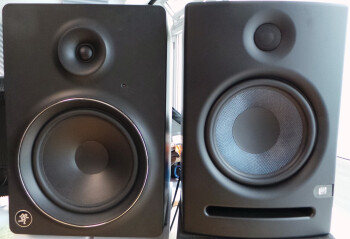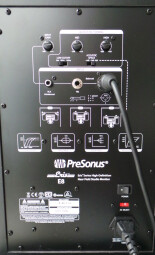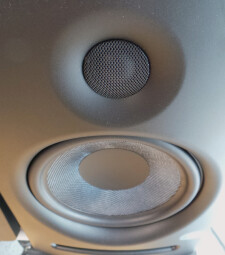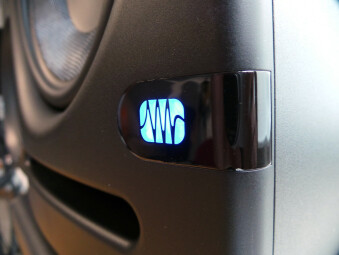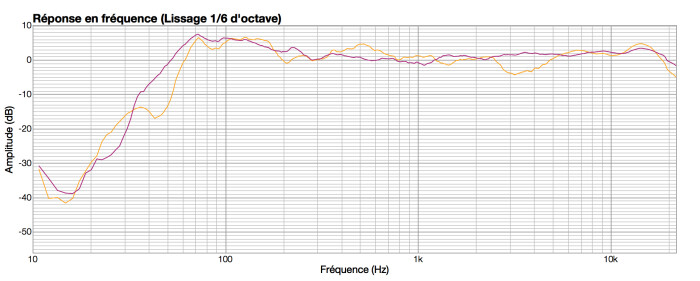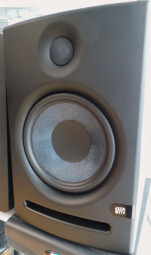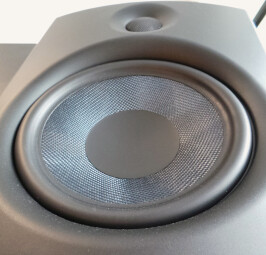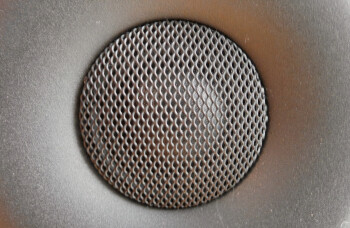In Greek mythology, Eris is the goddess of discord, but also of emulation: In the Iliad, Zeus asked him to inspire the Greek war chiefs on the battlefield. Does this first PreSonus monitor speaker inspire home-studio owners to create perfect mixes? The answer is here...
The manufacturer from Louisiana surprised everyone at the last NAMM show by announcing the launch of two monitor speaker series. The first family is called Sceptre. These speakers have a coaxial design and definitely belong to the high-class market segment. On the other hand, the Eris series are much more affordable and can directly compete with successful products like the Mackie MRmk3 and Yamaha HS. Nevertheless, PreSonus is still a newcomer to this market so the battle will be tough. But luckily, the Eris E8 we review here has more than one trick up its sleeve…
It’s a Black Box
After unpacking, the Eris doesn’t look sexy right from the start. In fact, the overall design is nice and very sleek. But don’t judge a speaker by it’s cover. Compared with the Mackie MR8mk2 in our studio, the Eris looks quite compact (9.84" × 11.77" × 15.12"). The Mackie is higher, wider and deeper. It also weights 4 lbs more than the E8 (22.2 lbs). The E8 front looks classy with its bass-reflex port and its illuminated PreSonus logo showing that the monitor is powered on.
The rear panel provides three input connections: RCA for unbalanced signal sources, 1/8" TRS and XLR for balanced signal sources. Note that if you have a 1/8" TS plug, you must use a TS/RCA adapter and connect the source signal to the RCA input. An input gain control is provided so that you can set the level before the signal reaches the amplification stage. Unfortunately the power switch is on the rear panel, but the latter surprised us with the numerous settings it provides. You get a high-frequency control, which is a high-shelving filter @ 4.5kHz (±6dB) and a mid-frequency filter @ 1kHz (±6dB too). You also get a low-cut filter @ 80Hz or 100Hz (-12dB/oct. slope), plus an “acoustic space” control which is a low-shelving filter @ 800Hz (-2dB or –4dB attenuation) allowing you to compensate for the bass boost when the speaker stands next to a wall or in a room corner. So when it comes to setting possibilities, the Eris E8 clearly beats our Mackie MR8mk2 which has neither mid-frequency control nor low-cut filter!
Internal Beauty
The Eris E8 is a two-way active speaker including two amplifiers. Each of them drives a single speaker, either the 8" woofer with kevlar membrane or the 1.25" silk dome tweeter. The low-frequency amplifier provides 75W and the tweeter amplifier 65W. The crossover splits the input signal at 2.2kHz (low+mid frequencies for the woofer, high frequencies for the tweeter), then each signal portion is sent to a single amplifier. This means all frequencies above 2.2kHz are reproduced by the tweeter, all frequencies under 2.2kHz by the woofer. The speaker cabinet is made out of MDF wood covered by a slim vinyl layer.
Now that you know everything about this speaker, let’s give it a try.
Listening
To test the speakers, we put them in front of the Mackie MR8mk2 which are directly competing products (by the way, the MR8mk3 has just been announced): They are sold at almost the same price and are equipped with an 8" woofer too. We decided to place the speakers vertically (horizontal placement is also possible) and started to listen to tracks we know very well, both in lossless and in 24bit/96kHz quality (Thanks Qobuz!) via our Metric Halo ULN-8 audio interface.
For the MR8mk2 review, we gave 2dB attenuation to the high-frequency range using the dedicated rear setting because the default setting gave not enough highs. On the other hand, we liked the low-frequency range a lot, even if it was impossible to attenuate it in certain situations.
Our A/B listening underscores the particular color of the Mackie’s once again: The frequency response of the E8 is more linear from 3kHz to 5kHz while this frequency range is slightly attenuated in the Mackie (but the settings help you to compensate for this attenuation). The low-mids by 500–600Hz are slightly weaker in the PreSonus, but this is not a negative thing, and the low-frequency range is similar.
Detailed comments on the tracks we listened to:
Melody Gardot — Mira
Without changing the speaker settings, the Mackie’s sound much more “boxy” than the PreSonus’ because the 3–5kHz range is pretty attenuated in the MR8mk2. An important thing is that the PreSonus’ doesn’t sound sharp, so they easily allow low listening sessions. With the acoustic instruments in this Melody Gardot song, the result is irrevocable: With the Mackie’s, a lot of details get lost in the high-mid and high frequency ranges, especially instrument attacks (acoustic guitar) and vocal presence. And we all know that this frequency range is crucial when mixing… As for the other frequencies, the Mackie speakers slightly boost the sound by 500Hz while the PreSonus’ stay more linear. The bottom-end is well reproduced by both speakers thanks to their 8" woofers. The low-frequency roll-off is audible from 50Hz with the PreSonus and from 60Hz with the Mackie. You already understood that we prefer the frequency response of the PreSonus in every aspect, while dynamic range and stereo imaging are similar with both speakers.
Metallica – Enter Sandman
The multiple guitar layers in this song make it easy to hear the difference between both speakers in the high-mid range. Of course, all tom-tom and snare attacks cut better through the mix with the PreSonus. The low-mid range is still a bit emphasized with the Mackie’s, which highlights the bass guitar. In the bottom-end, the sound difference between both speakers is less obvious. It’s important to note that, even if they give more high-mids and highs, the Eris never sound too sharp, which is a strong advantage. This song confirms our preference for the PreSonus speakers: With default settings, they sound more linear and offer more controls than the Mackie’s.
Strauss — Also sprach Zarathustra
We close our listening session with “Also sprach Zarathustra”. With the Mackie’s, the strong low-mids emphasize the resonance of the kettledrums, while the high-mids in the PreSonus make brass instruments cut through the orchestra. The track is a bit less readable with the Mackie’s than with the PreSonus’ because of the slight imbalance between low-mids and high-mids. The instruments in the orchestra are better defined with the Eris E8.
We made some speaker measurements but they have only a limited informative value since we have no anechoic chamber. Yellow curve for Mackie, purple curve for PreSonus.
Conclusion
For their first attempt in the monitor speaker market, PreSonus start with an already technically mature product. The Eris E8 offers high-quality construction, comprehensive input connections and extensive setting possibilities (low-cut filter plus low, mid and high filters) at an affordable price ($250 for a single monitor). During our listening sessions, the speaker seduced us because it reveals no real weakness. The frequency response is very smooth, even smoother than the Mackie we liked so much two years ago, all frequencies are reproduced effortless. This also applies to the dynamic range and the stereo imaging. This E8 monitor speaker is the autumn hot deal in the lower mid-class market segment.


